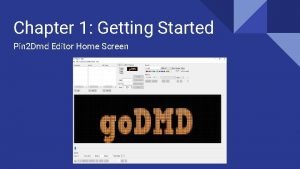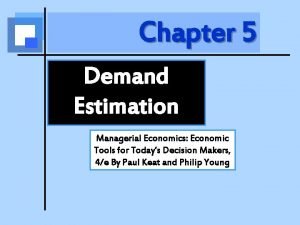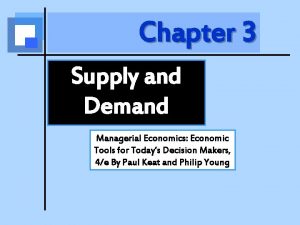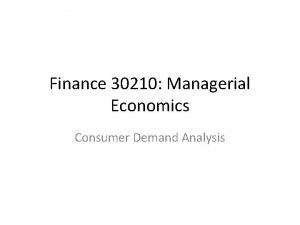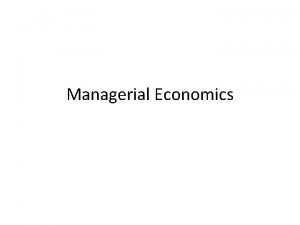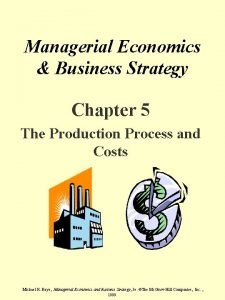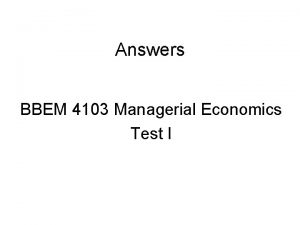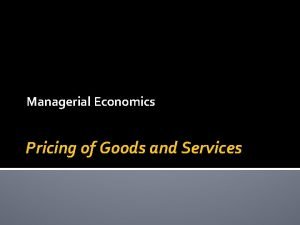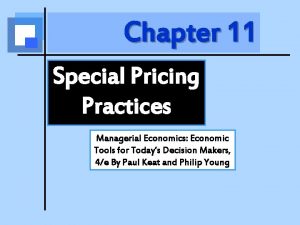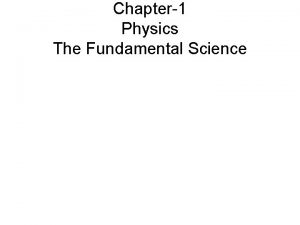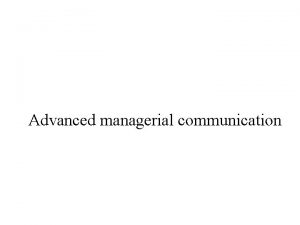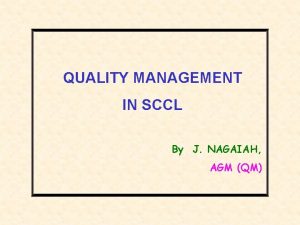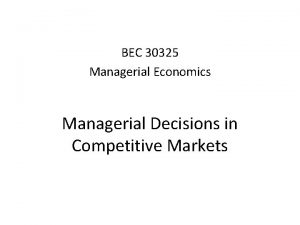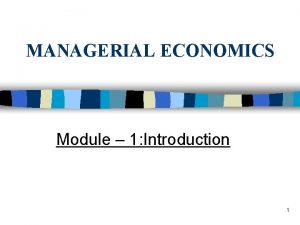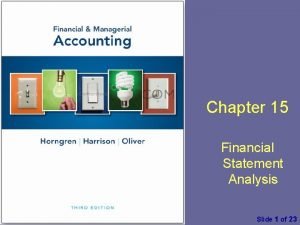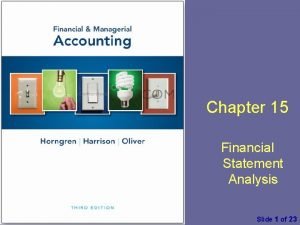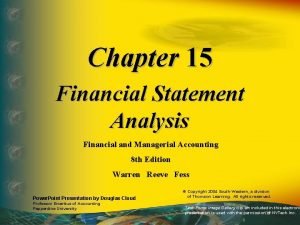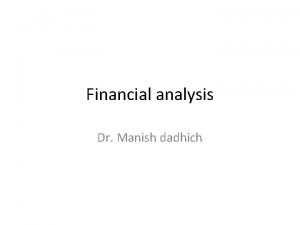MANAGERIAL ECONOMICS FINANCIAL ANALYSIS CHAPTER1 Mr K NAGAIAH






















- Slides: 22

MANAGERIAL ECONOMICS & FINANCIAL ANALYSIS CHAPTER-1 Mr. K. NAGAIAH, (Ph. D). / Ms. RUHI AFREEN/ Ms. S. RUBEENA ASSISTANT PROFESSOR DEPARTMENT OF MANAGEMENT STUDIES

INTRODUCTION TO MANAGERIAL ECONOMICS The managerial economics is concerned with those aspects of economics and its tools of analysis which are used in the process of decision making of business enterprises. DEFINITIONS OF MANAGERIAL ECONOMICS: • Spencer and Siegelman define “Managerial economics is the integration of economic theory with business practice for the purpose of facilitating decision making and forward planning by management”. • Brigham and Pappas believe that managerial economics is “the application of economic theory and methodology to business administration practice. ”

NATURE OF MANAGERIAL ECONOMICS 1. Close to Micro economics 2. Operates against backdrop of macro economics 3. Normative statements 4. Prescriptive actions 5. Applied in nature 6. Offers scope to evaluate each alternative 7. Interdisciplinary 8. Assumptions and Limitations

SCOPE OF MANAGERIAL ECONOMICS 1. Demand Decision 2. Input-Output Decision 3. Price-Output Decision 4. Profit-related Decisions 5. Investment Decisions 6. Economic forecasting and forward planning

DEMAND ANALYSIS Ø Desire on the part of the buyer to buy Ø Willingness to pay for it. Ø Ability to pay the specified price for it. The willingness of buyer to pay money for some quantity of a particular good or service. Ex: - I want a car and I cannot pay for it there is no demand for it from my side.

TYPES OF DEMAND �PRICE DEMAND: Price demand refers to the quantity of a product or service demanded at a given price. �INCOME DEMAND: Income demand refers to the quantity of a particular product or service demanded at a given level of income of the consumer or the households. �CROSS DEMAND: Cross demand refers to the quantity demanded of a particular product or service for a given price of the related goods. The related goods may be complementary or substitute goods.

LAW OF DEMAND The law of demand states “Other things remaining the same, the amount of quantity demanded rises with every fall in the price and vice versa. ”

EXCEPTIONS TO THE LAW OF DEMAND �GIFFEN’S PARADOX �PRESTIGIOUS GOODS �SPECULATION

CHANGES IN DEMAND Increase in Demand: If the consumer is willing and able to buy more of the product or services at the same price, the result will be an increase in demand then the demand curve will shift to the right.

Decrease in Demand: A decrease in demand occurs when buyers are ready to buy less of a product at the same price because of facts like fall income, rise in price of complimentary goods and so on. Movement along a demand curve indicates that a higher quantity is demand for a given fall in the price of the goods

Extension and contraction in demand: A contraction is the upward movement along a demand curve which indicates that a lower quantity is demanded for a given increase in the price of the goods.

ELASTICITY OF DEMAND Definition �The elasticity of demand is defined as the rate of responsiveness in the demand of a commodity for a given change in price or any other determinants of demand. �In other words, elasticity of demand refers to the degree of sensitiveness or responsiveness in the demand due to change in price.

TYPES OF ELASTICITY OF DEMAND q Price elasticity of demand: - = Proportional change in the quantity demanded Proportional change in the price q Income elasticity of demanded: - = Proportional change in the quantity demanded Proportional change in the Income q Cross elasticity of demand: X = Proportional change in the qty demanded of product Proportional change in the price of Product Y q Advertising elasticity of demand: = Proportional change in the quantity demanded Proportional change in the advertisement expenditure

SIGNIFICANCE OF ELASTICITY OF DEMAND �Price determination �Joint products �To Government �International Trade �To the finance minister

MEASUREMENT OF ELASTICITY OF DEMAND





DEMAND FORECASTING “Demand forecasting is an estimation of demand during as specified future period based on a proposed marketing plan and particular uncontrollable and competitive forces”.

FACTORS GOVERNINIG THE DEMAND FORECASTING v. Purchasing power of customers v. Price v. Substitutes v. Complementary v. Nature of the goods v. Degree of competition v. Socio-economic condition of the country v. Credit conditions v. Demography v. Time factors(long term or short term

METHODS OF DEMAND FORECASTING q. Survey methods: • Survey of buyer intention • Sales force opinion method q Statistical methods: • Trend projection methods • Barometric Techniques • simultaneously equation method • Correlation and regression methods q. OTHER METHODS • Expert opinion method • Test marketing: • Controlled experiment: • Judgmental approach
 Of mice and men chapter1
Of mice and men chapter1 Revelation chapter 1
Revelation chapter 1 Dmd chapter 1
Dmd chapter 1 Regression analysis in managerial economics
Regression analysis in managerial economics Demand and supply analysis in managerial economics
Demand and supply analysis in managerial economics Managerial economics demand analysis
Managerial economics demand analysis Management economics definition
Management economics definition Incremental reasoning in managerial economics
Incremental reasoning in managerial economics Managerial economics
Managerial economics Demand estimation and forecasting
Demand estimation and forecasting Scope and nature of managerial economics
Scope and nature of managerial economics Ecomics
Ecomics Managerial economics meaning and definition
Managerial economics meaning and definition Cost theory and estimation in managerial economics
Cost theory and estimation in managerial economics Basic concepts of managerial economics
Basic concepts of managerial economics Managerial economics test questions and answers
Managerial economics test questions and answers Transfer pricing in managerial economics
Transfer pricing in managerial economics Game theory managerial economics
Game theory managerial economics Managerial economics 12th edition mark hirschey
Managerial economics 12th edition mark hirschey Fundamental concepts of managerial economics
Fundamental concepts of managerial economics Scope of managerial economics
Scope of managerial economics How managerial economics is useful to engineers
How managerial economics is useful to engineers Pricing practices in managerial economics
Pricing practices in managerial economics


